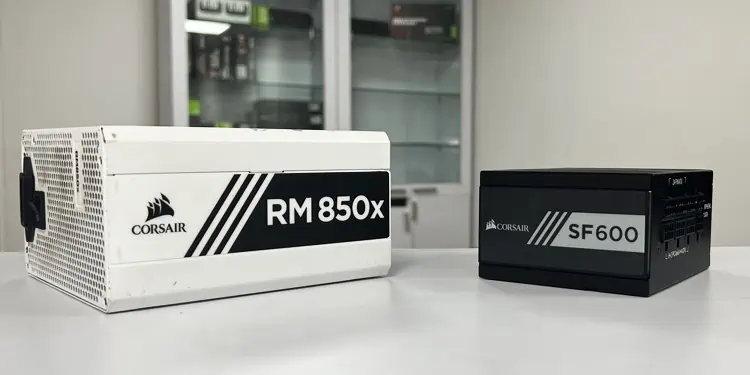When it comes to Power Supply Units (PSUs,) there are mainly two form factors that dominate the market today—ATX and SFX. The term ‘form factor’ here describes the physical shape and size of a PSU that determines how seamlessly it can be integrated into your build.
ATX power supplies, due to their larger size, are most common for building PCs in full tower and mid-tower cases. It’s an excellent choice for anyone who wants to build a high performance machine. On the flip side, SFX ones are relatively smaller in size and a better option for those who prioritize compact builds without compromising power supply efficiency.
In this article, I have tried to include every aspect of ATX and SFX power supplies that will help you gain a comprehensive understanding of both of them. By the end, you’ll also be able to decide what will be the best bet for your build.
What is ATX Power Supply
Advanced Technology Extended (ATX) is the most commonly used PSU form factor that is 150mm wide, 86mm tall and 140mm deep. While these measurements hold true for the ATX PS/2 variants, the PS/3 variants have a smaller depth of 100mm.
You may further notice a slight difference on the dimensions depending upon your PSU manufacturer.
For instance, I took the measurements of my CORSAIR RM850X and found that its actual dimensions were 150mm x 86mm x 160mm instead.
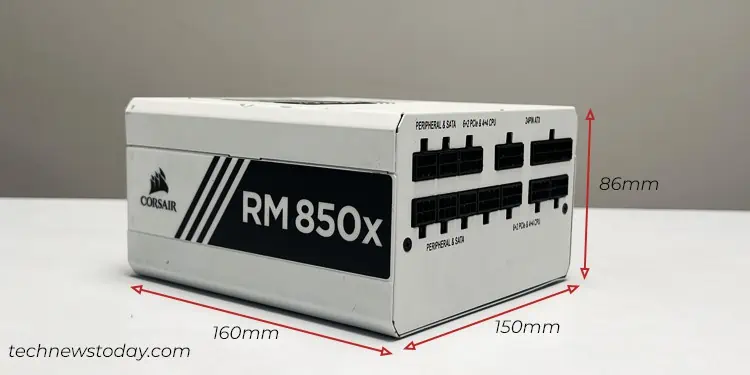
Below is a list of some pros and cons that will help you better analyze the ATX form factor.
- Suitable for a wide range of builds
- Too large for compact builds
- Cheaper than SFX ones (for same wattage and efficiency rating)
What is SFX Power Supply
SFX power supplies are a real life example for PC builders to prove “Happiness also comes in small packages.” Because two PSUs, one ATX and another SFX (with same specs) can deliver the same power and efficiency to your setup despite the smaller size of the SFX ones.
This kind of PSU is 125mm wide, 63.5mm tall and 100mm deep. The SFX PSUs also have a SFX-L variant that has quite a larger depth for accommodating larger fans.
Referring to a few SFX PSUs I own, like a CORSAIR SF600, I can confirm that the dimensions specified by the SFX standard are accurate, although it may slightly vary for other models.
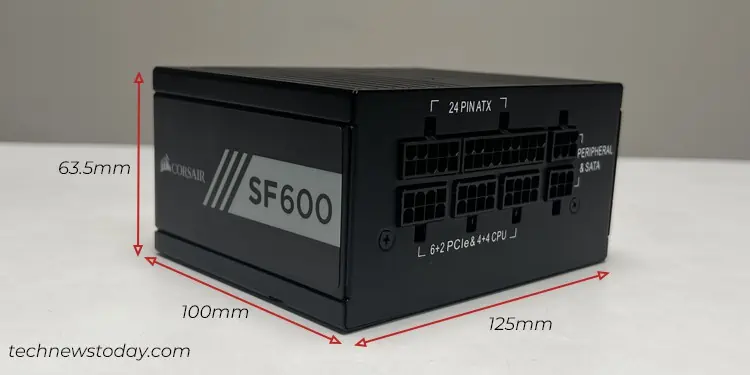
- Best suited for compact builds like Mini-ITX and Small Form Factor
- Small yet powerful and efficient for gaming PCs
- High wattage PSUs are not available for building high-end rigs
- Expensive than ATX ones (for same specs)
Differences Between SFX and ATX Power Supply
SFX and ATX are simply the form factors of a Power Supply Unit. So you may not find a significant difference between them in terms of their working mechanism.
They also share a few similarities like the identical power supply connectors and the efficiency ratings. Meanwhile the higher-end variants of both the kinds come with safety benefits like OCP and OVP.
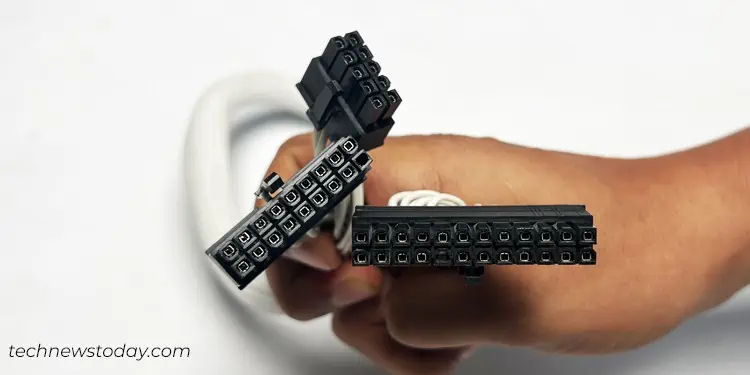
Nonetheless, we also get to see some striking differences between these two. In this section, I will discuss the major ones in the best possible way. By the end, it will help you decide which one will best suit the needs of your build.
Dimensions
The first and the most noticeable difference between these two form factors is their physical shape and size.
Referring to the dimensions discussed earlier, the ATX form factors are larger in size in comparison to the SFX ones. This makes the ATX PSU preferable for super tower, full tower or mid-tower build and the SFX ones for mini-tower, small form factor or HTPC builds.
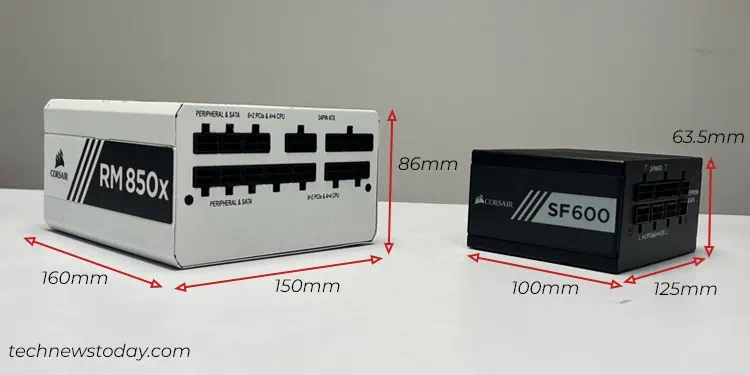
Having said that, it does not necessarily mean that you can not use SFX PSUs with the ATX cases. Most of the SFX PSUs include an SFX to ATX adapter for accomplishing this. If you don’t have one, you can also quickly grab it from the nearby store.
But I don’t see any point in using a SFX form factor in your ATX build unless you need some extra space, or if you already have one from your older build.
Further, the cables that come with the SFXs are comparatively shorter. So, it might be quite tedious to use the SFX PSUs with the ATX cases. To counter this problem, you can, however, purchase longer cables from your manufacturers.
On the other hand, not all but some small cases also allow you to use the ATX form factor with your SFF builds. You can quickly check the PC case specs to verify if it allows doing so. Although made possible, you may have a hard time fitting into the limited space and managing the cables.
Rated Output Power
The rated output power of an ATX power supply generally starts anywhere from 300 watts and can go up to 2000 watts.
Similar to the ATX ones, the entry-level SFX power supplies are also available starting from 300 watts. But there are only a few ones that go beyond 1000 watts. So, if your power requirement is too high, you may have problems finding the SFX ones.
Nonetheless there are some PSU models like the Cooler Master V1300 SFX Platinum that claims itself to be the highest wattage (1300 watts) SFX PSU in the market. You can opt for these models too if you seek compact and high-end rigs.
Modularity
If you go with the ATX ones, you have the freedom to choose between non-modular, semi-modular or a modular PSU. The choice all depends on your cable management skills.
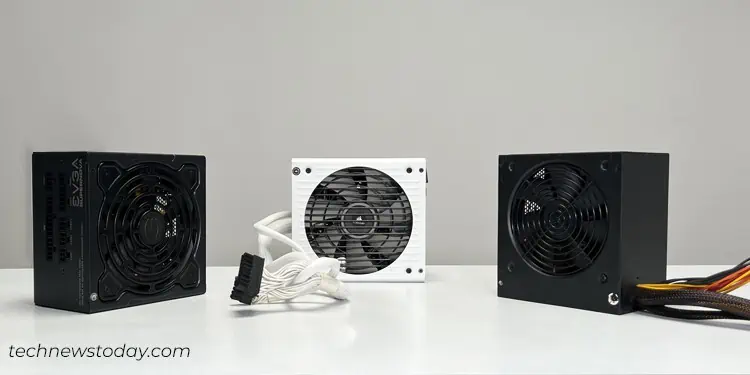
On the other hand, SFX PSUs generally come in modular variants. Since they are mostly designed for compact build, it would be a head-scratching job managing the cables if you choose other variants.
Noise and Cooling
SFX power supplies have smaller fan blades in comparison to the ATX ones because of space restrictions. As such, it requires the PSU fans to rotate at a higher speed so that it could maintain the airflow as the ATX one of the same specs would do.
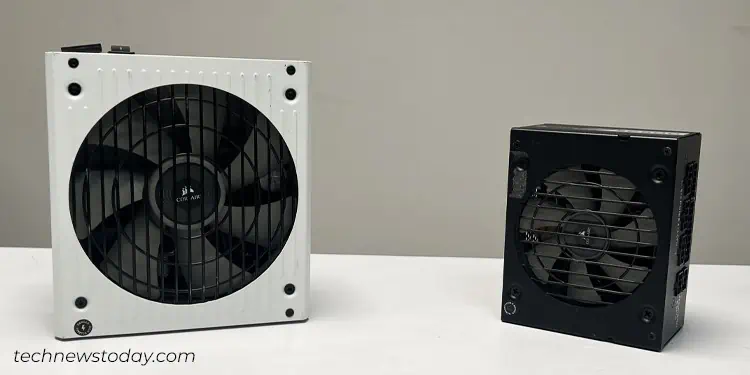
This may also cause the PSU to overheat when you are using your system at a full load, causing thermal throttling in the long run.
Further, the limited space has made it challenging for the manufacturers to integrate the noise reduction technology like acoustic dampening. This significantly increases the noise level in the SFX PSUs.
You may experience a noise level anywhere around 20dB in case of an ATX PSU and about 30dB in SFX ones. It can somehow affect your PC experience if you are in a pin-drop silent room.
Having said that, I don’t mean you should not get a SFX PSU. With advancements in technology, they are made much quieter these days. You can always check the noise ratings of the device before you purchase it.
If you seek more quieter fans, I suggest you go for one that has a fluid dynamic bearing. When the shaft on these fans rotate, a film of pressurized fluid is built that does not let it come in contact with the bearing, making it almost noiseless. These fans also have a much higher life expectancy but are expensive than the normal ones.
Nevertheless, both the variants have a semi-passive or smart zero fan feature that allows the fan to lower the speed or completely turn it off when the system is running less on load, or say is idle.
Price and Availability
“SFX comes with the power of ATX crammed in a smaller case.” So it would be a no-brainer to state that the SFX power supplies are priced a bit higher than the ATX ones.
On the other hand, ATX units are far more common than SFX ones and are manufactured in bulk, reducing the overall manufacturing cost.
Further, SFX PSUs use specialized components and go through rigorous manufacturing processes making the price justifiable.
When it comes to availability, both of them are commonly available across the stores and you should have no problem getting one for your setup.
Final Comparison – SFX Vs ATX
Now that you are at the end of the article, you might have already figured out which form factor best aligns with your needs.
Revising the points we discussed earlier, I recommend using a SFX PSU if you are into building mini PCs and if the space is a matter of concern. On the other hand, the ATX ones will always be the best choice if you have no space restriction.
As an additional tip, I also recommend you go for the one that is ATX 3.0 compatible. It is a newer standard for PSUs that integrate a PCIe 5.0 +12VHPWR port for connecting high-end power-hungry GPUs that demand up to a whooping 600W at full load.
Besides, these PSUs come equipped with the spike resistance feature that helps to tackle the momentarily power spikes, as reportedly seen in the RTX 3000 series. Few examples of such PSUs include SilverStone Technology HELA 1300R Platinum and MSI MPG A1000G.
Unlike the name, the ATX 3.0 standard does not only imply the ATX form factors. You can also get the SFX PSUs that are ATX 3.0 compatible.
Further, you should also go with the one that has a higher power supply efficiency. It not only ensures efficient power supply to your rig but also wastes less energy as heat, ultimately improving the cooling of your system.
You can also quickly go through our another article on 80 PLUS Gold vs 80 PLUS Platinum power supply that will help you decide.

